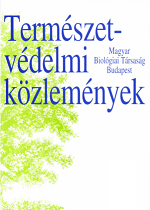Data to the management of the Adriatic lizard orchid populations in Hungary
Abstract
The effective protection of species requires a detailed knowledge of their biology. The Adriatic Lizard orchid (Himantoglossum adriaticum H. Baumann) is a Natura 2000, CITES species, and a strictly protected plant in Hungary. This orchid has four larger and one smaller populations in Hungary (other satellite locations are also known). We counted the flowering individuals in all of the larger populations in Hungary between 2013 and 2017. Altogether 1903 inflorescences were tagged to record the height of the flowering stalk, the length of inflorescence and the number of flowers and fruits. We found 34–179 flowering shoots in each population per year. The reproductive success varied between 9.2 and 61.7% (mean=33.5±15.6, n=20) in the populations. There were lower (typically around 20% annual averages) fruit set in Keszthely and Sümeg, and higher in Kőszeg and Nagytevel (around 30–60% annual averages). Among the traits, the height of the shoot and the length of the inflorescence were not independent from each other, accordingly they changed in the same way: they differed significantly between places and years too, and the interaction of years and places was also significant. The smallest variability was shown by the number of flowers: only the Sümeg population differed from the others, the flower number was significantly lower here. The number of fruits and reproductive success also differed significantly between years and places. On the basis of the Corine surface cover, the Keszthely and Sümeg populations occur in forested areas or in forested and scrubland mosaic, while the population of Kőszeg and Nagytevel grow in a complex of meadow and cultivated areas. The number of the flowers in the inflorescences is a stable trait, but reproductive success is influenced by the location and the environmental factors of the given year. Recognizing these background factors is a key task for preserving populations.
References
Biró, É., Bódis, J., Nagy, T., Tökölyi, J. & Molnár, V. A. (2015): Honeybee (Apis mellifera) mediated increased reproductive success of a rare deceptive orchid. – Appl. Ecol. Env. Res. 13: 181–192. doi: https://doi.org/10.15666/aeer/1301_181192
Brzosko, E. (2003): The dynamics of island populations of Platanthera bifolia in the Biebrza National Park (NE Poland). – Ann. Bot. Fenn. 40: 243–253.
Carey, P. D., Farrell, L. & Stewart, N. F. (2002): The sudden increase in the abundance of Himantoglossum hircinum in England in the past decade and what has caused it. – In: Kindlmann, P., Willems, J. & Whigham, D. F. (eds): Trends and fluctuations and underlying mechanisms in terrestrial orchid populations. Backhuys Publishers, Leiden, pp. 187–208.
Fekete, R., Nagy, T, Bódis, J., Biró, É., Löki, V., Süveges, K., Takács, A., Tökölyi, J. & Molnár, V. A (2017): Roadside verges as habitats for endangered lizard-orchids (Himantoglossum spp.): Ecological traps or refuges? – Sci. Total Envir. 607–608: 1001–1008. doi: https://doi.org/10.1016/j.scitotenv.2017.07.037
Jacquemyn, H., Brys, R. & Hermy, M. (2002): Flower and fruit production in small populations of Orchis purpurea and implications for management. – In: Kindlmann, P., Willems, J. & Whigham, D. F. (eds): Trends and fluctuations and underlying mechanisms in terrestrial orchid populations. Backhuys Publishers, Leiden, pp. 67–84.
Kindlmann, P. & Jersakova, J. (2006): Effect of floral display on reproductive success in terrestrial orchids. – Folia Geobot. 41: 47–60. doi: https://doi.org/10.1007/BF02805261
Király, G. (szerk.) (2007): Vörös Lista. A magyarországi edényes flóra veszélyeztetett fajai. – Saját kiadás, Sopron, 73 p.
Kull, T. (2002): Population dynamics of north temperate orchids. – In: Kull, T. & Arditti, J. (eds): Orchid biology: reviews and perspectives, VIII. Kluwer Academic Publishers, Dordrecht, pp. 139–165.
Németh, F. & Seregélyes, T. (1981): Ne bántsd a virágot! Néhány ritkaság a hazai flórából. OKTH-MTI, Budapest. 131 p.
Øien, D-I. & Moen, A. (2002): Flowering and survival of Dactylorhiza lapponica and Gymnadenia conopsea on the Solendet Nature Reserve, Central Norway. – In: Kindlmann, P., Willems, J. & Whigham, D. F. (eds): Trends and fluctuations and underlying mechanisms in terrestrial orchid populations. Backhuys Publishers, Leiden, pp. 3–22.
Óvári, M. (2017): A Himantoglossum adriaticum Baumann a Kelet-Zalai-dombságban. – Kitaibelia 22: 297–303. doi: https://doi.org/10.17542/kit.22.297
Pfeifer, M., Heinrich, W. & Jetschke, G. (2006a): Climate, size and flowering history determine flowering pattern of an orchid. – Bot. J. Linn. Soc. 151: 511–526. doi: https://doi.org/10.1111/j.1095-8339.2006.00539.x
Pfeifer, M., Wiegand, K., Heinrich, W. & Jetschke, G. (2006b): Long-term demographic fluctuations in an orchid species driven by weather: implications for conservation planning. – J. Appl Ecol. 43: 313–324. doi: https://doi.org/10.1111/j.1365-2664.2006.01148.x
Slaviero, A., Del Vecchio, S., Pierce, S., Fantinato, E., & Buffa, G. (2016): Plant community attributes affect dry grassland orchid establishment. – Plant Ecol. 217: 1533–1543. doi: https://doi.org/10.1007/s11258-016-0666-x
Tamm, C. (1991): Behaviour of some orchid populations in a changing environment. Observations on permanent plots, 1943-1990. – In: Wells, T. C. E. & Willems, J. H. (eds): Population ecology of terrestrial orchids. SPB Academic Publishing, The Hague, The Netherlands, pp. 1–13.
Waterman, R. J. & Bidartondo, M. I. (2008): Deception above, deception below: linking pollination and mycorrhizal biology of orchids. – J. Exp. Bot. 59: 1085–1096. doi: https://doi.org/10.1093/jxb/erm366
Wells, T. C. E. & Cox, R. (1991): Demographic and biological studies on Ophrys apifera: some results from a ten year study. – In: Wells, T. C. E. & Willems, J. H. (eds): Population ecology of terrestrial orchids. SPB Academic Publishing, The Hague, The Netherlands, pp. 47–63.
Whigham, D. F. & O’Neil, J. (1991): The dynamics of flowering and fruit production in two eastern North American terrestrial orchids, Tipularia discolor and Liparis lilifoli. – In: Wells, T. C. E. & Willems, J. H. (eds): Population ecology of terrestrial orchids. SPB Academic Publishing, The Hague, The Netherlands, pp. 89–101.
Zadravec, V., Zadravec, M. & Zadravec, M. (2014): Orchids of Vejalnica and Krc (Medvednica). – Glasnik Hrvatskog botanickog društva 2: 4–12.






